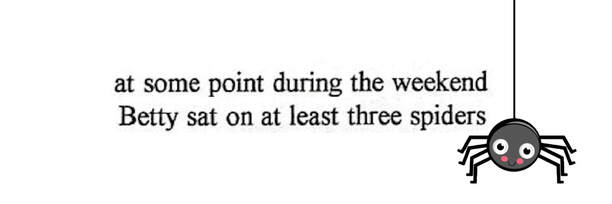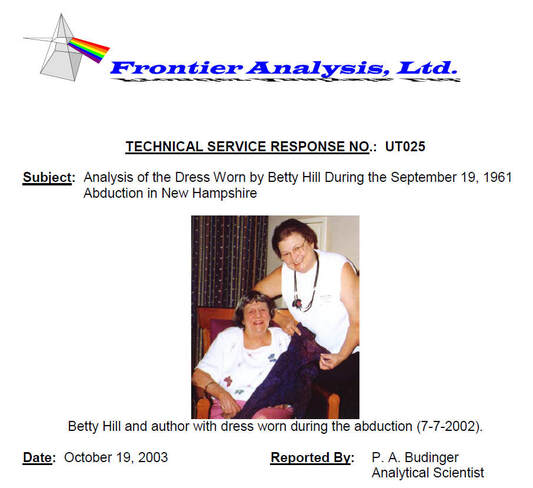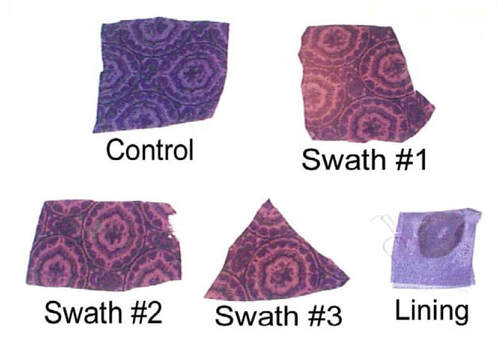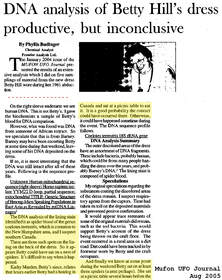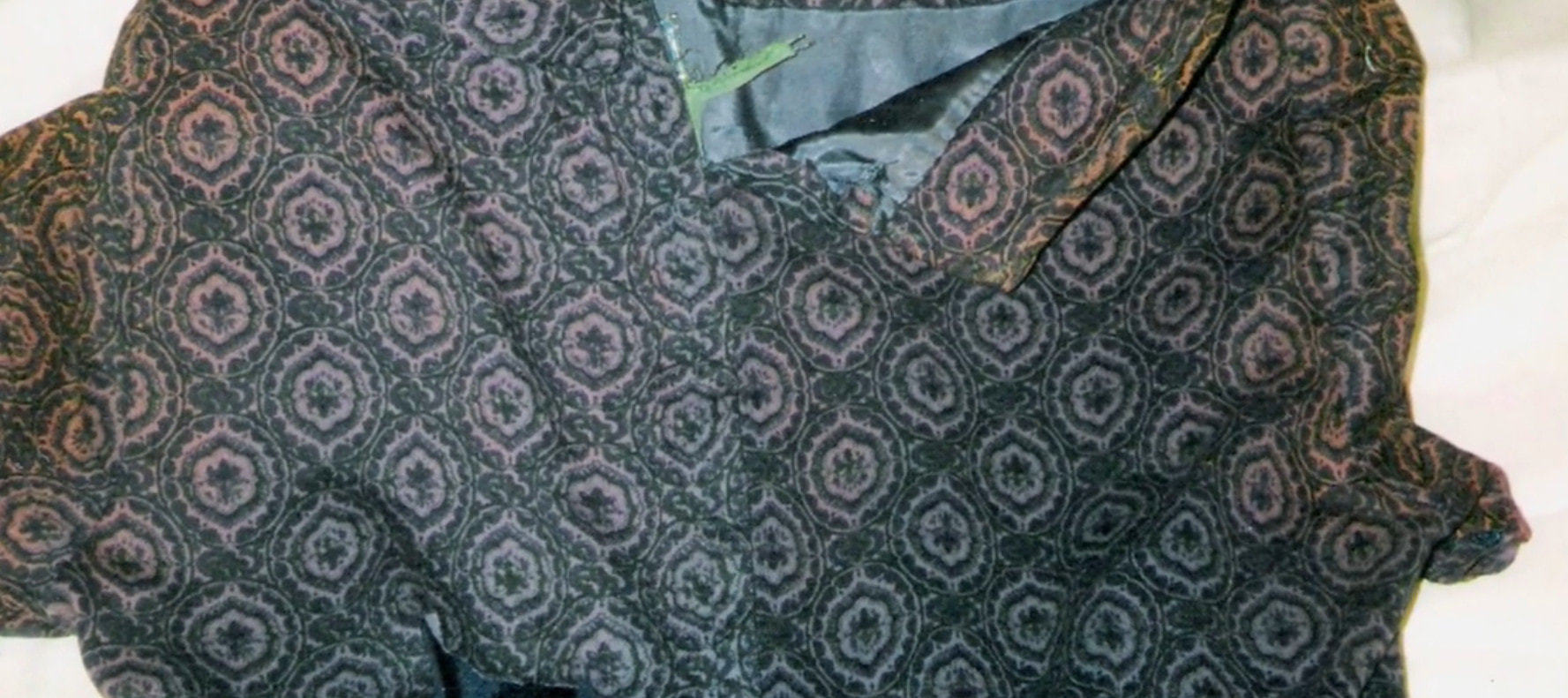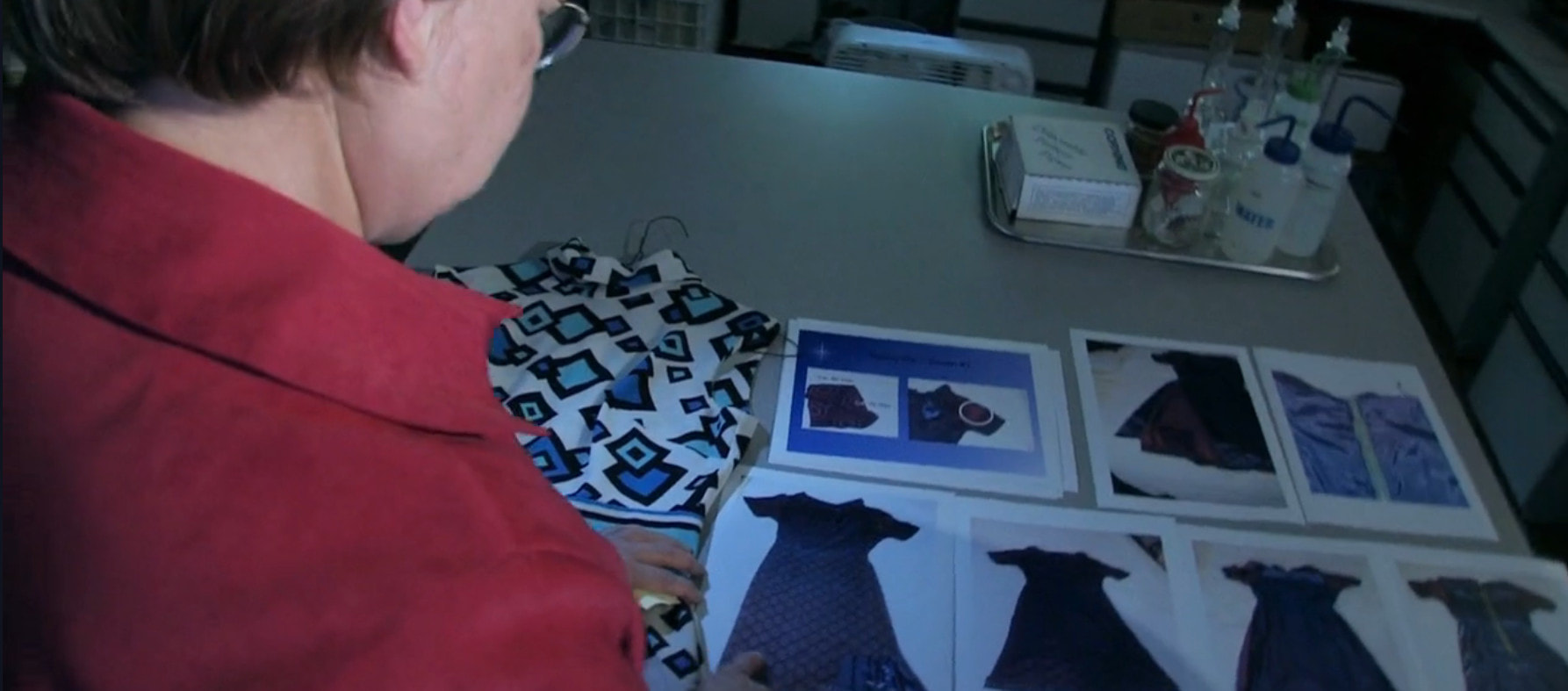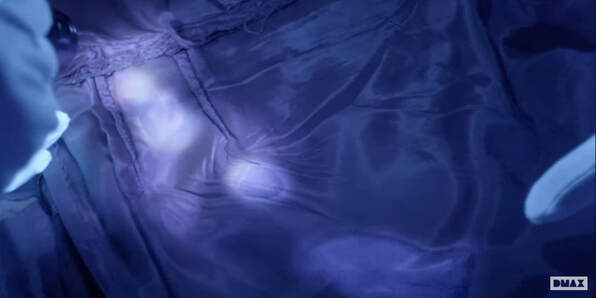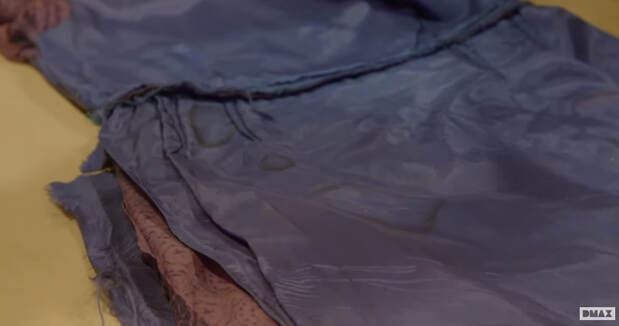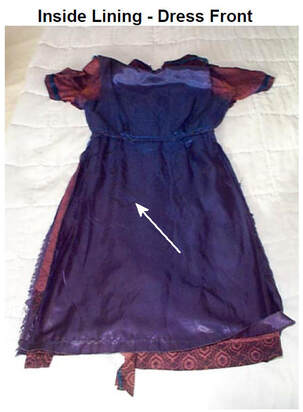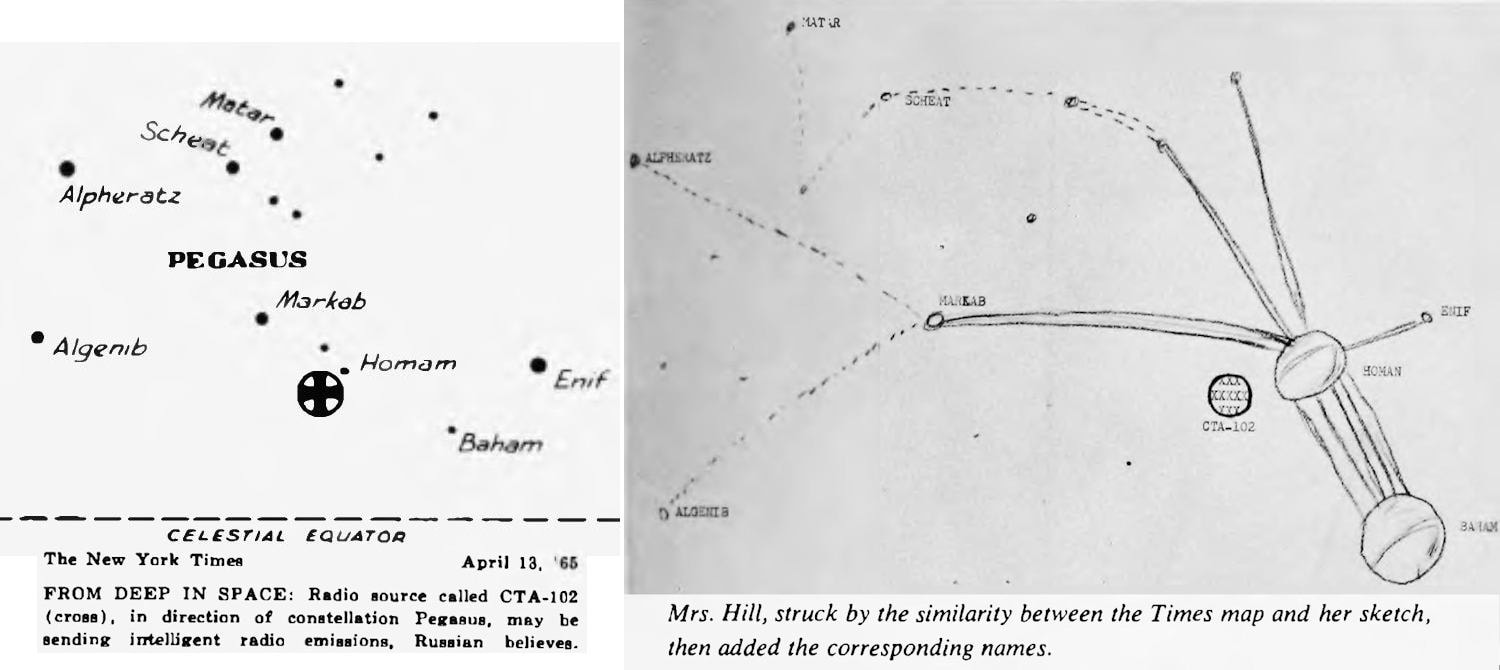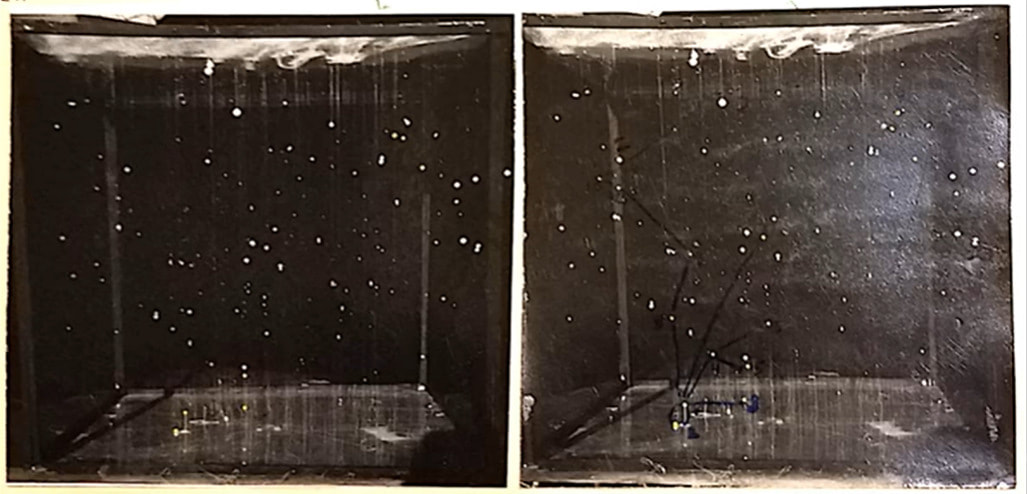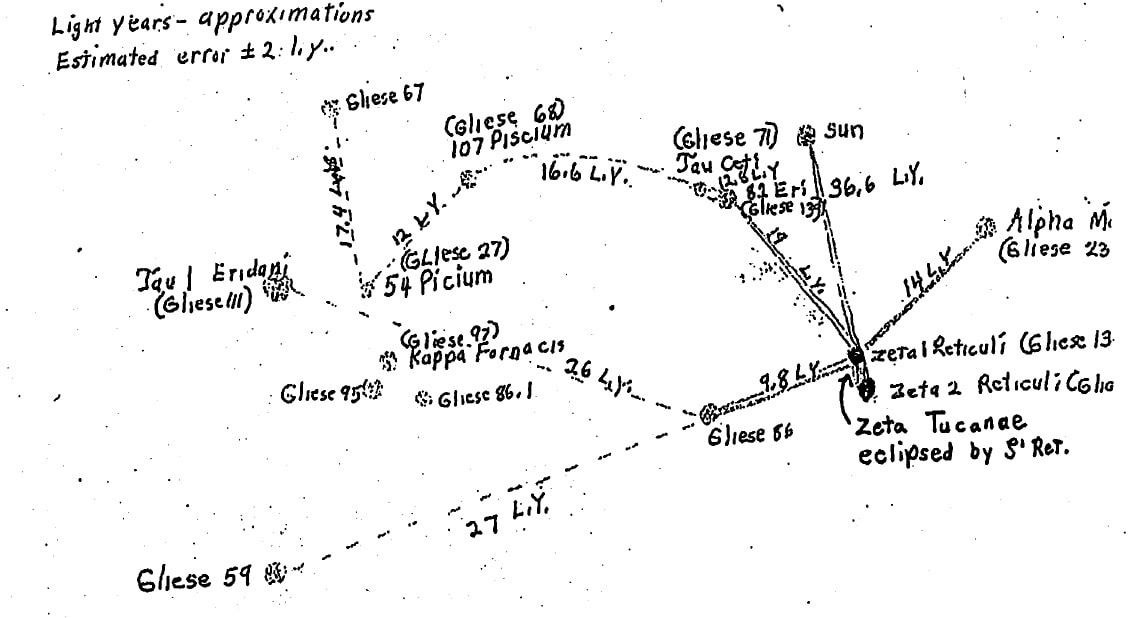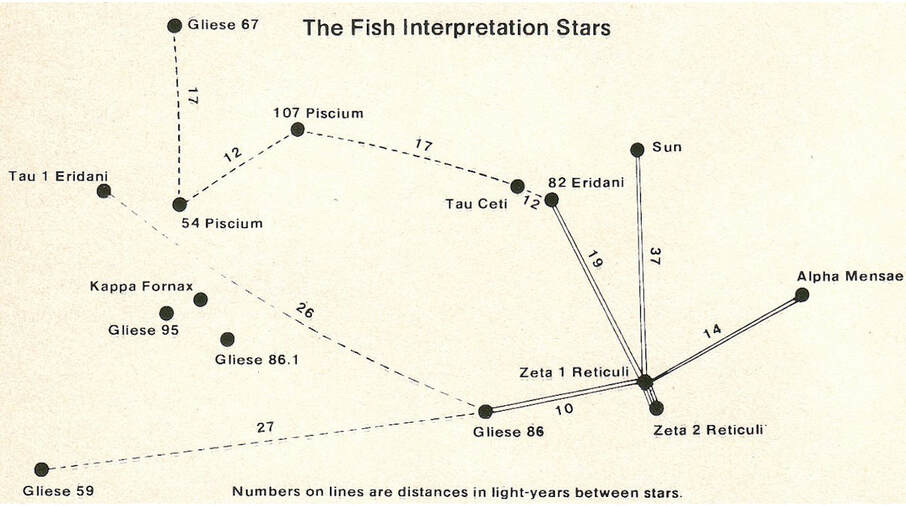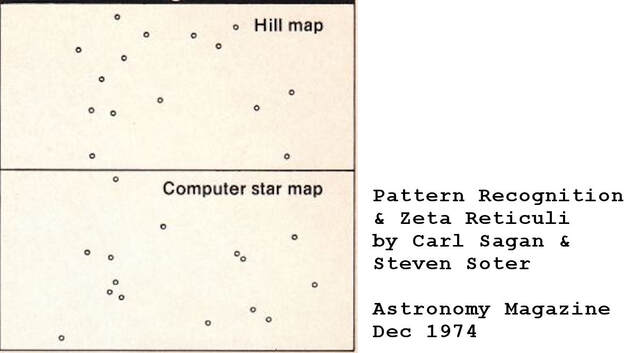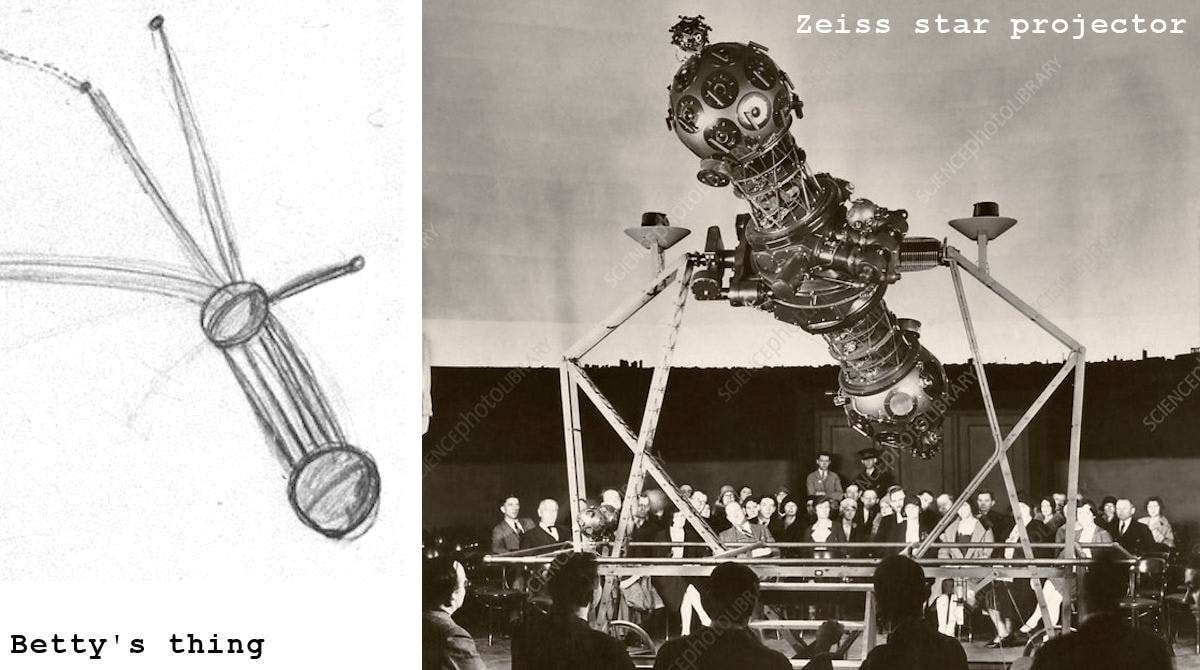Physical evidence |
. |
|
2: MEDDLE |
||
This page covers the physical evidence from the Hills' abduction:
Sorrow: The dress
Betty was wearing a new dress on the night of the drive, worn only once before (when she ate a picnic while on the vacation) and never washed. When she got home she folded up the dress and put it in the closet. According to Marden she forgot about it until years later, when hypnotherapy reminded her about it.
When Betty removed the dress from the closet, it was covered in a pink powder which blew away when she hung out the dress, leaving the fabric with discolored patches.
Back in the closet it went, never to be worn again but occasionally taken out to show visitors.
In Betty's interview with Webb, as well as her written-out dreams (both 1961), she never mentions the dress suffering any physical damage - not during the trip, during the medical examination by aliens, or afterward when she puts the dress away. Nor does it come up under hypnosis in 1964, nor is it reported in Fuller's 1965 book.
By the time the dress arrives for testing in 2002 the zipper and lining are torn. There are also references to the dress being torn in earlier newspaper articles but of course there were no articles until after the story broke in 1965.
Betty's niece Kathleen Marden used a "cognitive interviewing technique" to extract a story of the dress being damaged when Betty fought her captors and when Doc Alien struggled with the zipper. For all we know it was Betty's curious and very human visitors who damaged the dress. Maybe it was Dulsey. These terrestrial beings certainly would've deposited grime and DNA on it, making any future analysis rather pointless.
What's clear is that in September 1961, and for some years after, Betty did not report the dress was ripped. We have no evidence it was damaged during any alien abduction.
The powder apparently didn't fly away completely because in 1978 it and swatches from the dress were analyzed at the University of Cincinnati's Department of Chemistry and found to contain unremarkable elements and organic hydrocarbons [Captured!, Marden 2007, p. 264]. The discoloration could not be replicated using bleach, acid, base, UV exposure, or a sunlamp. For some reason nobody tried dumping moist dust on an unstained piece of fabric and leaving it to go moldy - given subsequent analysis concluded the powder was most likely a residue resulting from the growth of mildew.
In 2003 one Phyllis A. Budinger, with 35 years industrial experience in chemical analysis (she says in the petroleum industry) released a report on the dress. The front page looks like this:
When Betty removed the dress from the closet, it was covered in a pink powder which blew away when she hung out the dress, leaving the fabric with discolored patches.
Back in the closet it went, never to be worn again but occasionally taken out to show visitors.
In Betty's interview with Webb, as well as her written-out dreams (both 1961), she never mentions the dress suffering any physical damage - not during the trip, during the medical examination by aliens, or afterward when she puts the dress away. Nor does it come up under hypnosis in 1964, nor is it reported in Fuller's 1965 book.
By the time the dress arrives for testing in 2002 the zipper and lining are torn. There are also references to the dress being torn in earlier newspaper articles but of course there were no articles until after the story broke in 1965.
Betty's niece Kathleen Marden used a "cognitive interviewing technique" to extract a story of the dress being damaged when Betty fought her captors and when Doc Alien struggled with the zipper. For all we know it was Betty's curious and very human visitors who damaged the dress. Maybe it was Dulsey. These terrestrial beings certainly would've deposited grime and DNA on it, making any future analysis rather pointless.
What's clear is that in September 1961, and for some years after, Betty did not report the dress was ripped. We have no evidence it was damaged during any alien abduction.
The powder apparently didn't fly away completely because in 1978 it and swatches from the dress were analyzed at the University of Cincinnati's Department of Chemistry and found to contain unremarkable elements and organic hydrocarbons [Captured!, Marden 2007, p. 264]. The discoloration could not be replicated using bleach, acid, base, UV exposure, or a sunlamp. For some reason nobody tried dumping moist dust on an unstained piece of fabric and leaving it to go moldy - given subsequent analysis concluded the powder was most likely a residue resulting from the growth of mildew.
In 2003 one Phyllis A. Budinger, with 35 years industrial experience in chemical analysis (she says in the petroleum industry) released a report on the dress. The front page looks like this:
I'll be honest here. Maybe Budinger is wonderful scientist but... no. Just no. This doesn't look like a scientific report, it looks like fan mail.
Budinger is, in fact, a fan. She relates, straight-faced, the story of Betty and Barney's abduction and proceeds to interpret all her results within that framework. The discoloration is attributed to places where alien things touched the dress, like alien hands and the floor of a marigold-scented alien spaceship. The torn hem is because Betty kicked at her captors. The torn zipper is because the alien doc had trouble opening it. (Car door handles, though? No problem.)
For two years this scientist analyzed swatches of the dress, using a non-discolored piece as a control. Now personally, if I was looking for a control I'd head to my grandma's closet or to a vintage clothing store and find me a musty old 1960s cellulose acetate dress, have a picnic in it, wear it for 24 hours straight, leave it moldering for a few years, and cut that up. But what do I know? Budinger is the scientist here.
Budinger is, in fact, a fan. She relates, straight-faced, the story of Betty and Barney's abduction and proceeds to interpret all her results within that framework. The discoloration is attributed to places where alien things touched the dress, like alien hands and the floor of a marigold-scented alien spaceship. The torn hem is because Betty kicked at her captors. The torn zipper is because the alien doc had trouble opening it. (Car door handles, though? No problem.)
For two years this scientist analyzed swatches of the dress, using a non-discolored piece as a control. Now personally, if I was looking for a control I'd head to my grandma's closet or to a vintage clothing store and find me a musty old 1960s cellulose acetate dress, have a picnic in it, wear it for 24 hours straight, leave it moldering for a few years, and cut that up. But what do I know? Budinger is the scientist here.
Budinger did a million tests on these swatches and all I can think is that Betty must've been mightily underwhelmed by the analysis.
First, the good news: her conclusion was to find "nothing in the analytical data to dispute Betty and Barney’s account of the event." (This is like saying: "I was abducted by aliens and you can't prove I wasn't because look at the completely ordinary mud on the shoes I was wearing at the time.")
Particulate matter in the fabric was found to be "materials one would expect to find on a dress which has hung in the closet for four decades" - pet hair, skin cells, house dust, synthetic clothing fibers, and soap. Also found were natural oils and other biological material (protein) that might contain alien DNA, who knows, and caused mildew etc. to grow, discoloring the fabric.
In the 2009 documentary The White Mountain Abduction (Gray & Gray) Budinger says the discoloration is from mold, but because it's on the outside it didn't come from Betty. No kidding, right? Not having moldy skin that leaves mold deposits inside one's clothing seems fairly standard. Anyway, the mold must've come from another source. Budinger concludes: "In some ways this speculation would support Betty's story." You're asking "In what ways, exactly?" Well... I mean, it doesn't disprove Betty's story although Budinger doesn't say the mold was alien.
Before Betty had time to get excited about the alien DNA, in 2004 the dress underwent DNA analysis and the following DNA was found:
You can hear the sadness in Marden's tone when she writes: "the researchers could not confirm DNA evidence from other than Earthly sources."
The Pinelandia Biophysics Laboratory of Michigan soaked the dress swatches in water and grew wheat seeds using the water samples. I don't know why they did this. This is not something I would think of doing, so kudos I guess. Seeds germinated faster in water from the stained sample. You might think WOW! until you realize the control in this experiment was a piece of unstained dress fabric.
These results don't prove a thing about alien sweat making seeds germinate faster unless you assume your conclusion - that the stuff on the fabric was alien. Did anyone think to check if seeds germinate faster in water obtained by soaking fabric stained with Earth-sourced biological matter?
First, the good news: her conclusion was to find "nothing in the analytical data to dispute Betty and Barney’s account of the event." (This is like saying: "I was abducted by aliens and you can't prove I wasn't because look at the completely ordinary mud on the shoes I was wearing at the time.")
Particulate matter in the fabric was found to be "materials one would expect to find on a dress which has hung in the closet for four decades" - pet hair, skin cells, house dust, synthetic clothing fibers, and soap. Also found were natural oils and other biological material (protein) that might contain alien DNA, who knows, and caused mildew etc. to grow, discoloring the fabric.
In the 2009 documentary The White Mountain Abduction (Gray & Gray) Budinger says the discoloration is from mold, but because it's on the outside it didn't come from Betty. No kidding, right? Not having moldy skin that leaves mold deposits inside one's clothing seems fairly standard. Anyway, the mold must've come from another source. Budinger concludes: "In some ways this speculation would support Betty's story." You're asking "In what ways, exactly?" Well... I mean, it doesn't disprove Betty's story although Budinger doesn't say the mold was alien.
Before Betty had time to get excited about the alien DNA, in 2004 the dress underwent DNA analysis and the following DNA was found:
- bacteria
- domestic cattle
- human (Betty)
- human ("Hmong-Mien speaking populations in East Asia", which Marden reports as African[??!] a.k.a. Barney although more recently she says it's the DNA of an albino Chinese woman or something)
- mouse
- funnel weaver spider
You can hear the sadness in Marden's tone when she writes: "the researchers could not confirm DNA evidence from other than Earthly sources."
The Pinelandia Biophysics Laboratory of Michigan soaked the dress swatches in water and grew wheat seeds using the water samples. I don't know why they did this. This is not something I would think of doing, so kudos I guess. Seeds germinated faster in water from the stained sample. You might think WOW! until you realize the control in this experiment was a piece of unstained dress fabric.
These results don't prove a thing about alien sweat making seeds germinate faster unless you assume your conclusion - that the stuff on the fabric was alien. Did anyone think to check if seeds germinate faster in water obtained by soaking fabric stained with Earth-sourced biological matter?
|
Budinger wrote an article in the August 2005 MUFON UFO Journal with a summary of the DNA analysis on the dress and a few extra details. She is pathologically unable to deal with the disappointing lack of evidence for alien interference with this dress, and so assigns alien adventures for it as she pleases. The soil bacteria DNA found on the dress came not from any regular location where soil is found, but from the spaceship floor. In the next breath we learn of three spots of spider blood on the lining of the dress - "it appears Betty could have sat on a nest of spiders." So, spiders or spider nests don't contain soil bacteria?
|
Betty wore the dress for 24 hours straight as well as on an earlier day, without washing, and through several meals and outside walks. Soil and spider DNA could have been transferred onto it in a hundred ways - but no, the evidence shows that dress fell into a crumpled heap on an alien spaceship floor, dammit!
Ben Hansen's deceptive analysis for clicks
Ben Hansen examined the dress for the TV show UFO Witness (2021) excerpted here. This is perhaps the most deceptive presentation about the Hills case I've ever seen.
Along with Betty's niece Kathleen Marden, Hansen discovers two tiny holes on the dress and speculates a needle was used to take blood. Given how ridiculous it sounds for an alien doctor to take blood through clothing when Betty has plenty of exposed skin to stick a needle into, this morphs into the idea that her eggs were extracted. But Hansen never even specifies that the tiny holes are located over the position of Betty's ovaries. And why would aliens choose a 42-year-old woman to harvest eggs from? Eggs from a middle-aged woman are mostly duds.
Next, Hansen looks at the dress under UV light and after turning it inside-out discovers three stains on the lining.
Ben Hansen examined the dress for the TV show UFO Witness (2021) excerpted here. This is perhaps the most deceptive presentation about the Hills case I've ever seen.
Along with Betty's niece Kathleen Marden, Hansen discovers two tiny holes on the dress and speculates a needle was used to take blood. Given how ridiculous it sounds for an alien doctor to take blood through clothing when Betty has plenty of exposed skin to stick a needle into, this morphs into the idea that her eggs were extracted. But Hansen never even specifies that the tiny holes are located over the position of Betty's ovaries. And why would aliens choose a 42-year-old woman to harvest eggs from? Eggs from a middle-aged woman are mostly duds.
Next, Hansen looks at the dress under UV light and after turning it inside-out discovers three stains on the lining.
Wow! Looks like blood, he says. And given the stains are only on the lining (not the outside of the dress) and are 2 inches below the high waistband, he says, that places them over the navel - where Betty recalls a big needle was painfully inserted during her examination. Did she bleed onto the dress lining? It's evidence for her abduction!
Let's examine this claim. Firstly, the stains are perfectly visible under normal light, making it impossible that no previous researcher has ever noticed them before. And indeed, Budinger mentions the stains in her 2003 report. Yet Marden answers "no" when asked if she's seen them before. (Her answer is clearly cut short, so who knows what she really said.) Why this dramatic pretense that the stains have never been discovered before?
Let's examine this claim. Firstly, the stains are perfectly visible under normal light, making it impossible that no previous researcher has ever noticed them before. And indeed, Budinger mentions the stains in her 2003 report. Yet Marden answers "no" when asked if she's seen them before. (Her answer is clearly cut short, so who knows what she really said.) Why this dramatic pretense that the stains have never been discovered before?
There's no big hole where the navel-needle allegedly went in, and Betty recalls her dress was removed before that part of the examination. So if these stains are from her bleeding navel, they must have happened after she put the dress back on. Yet you'll note none of the stains are in the midline where we can presume Betty's navel was located on her anatomy. The top two stains are at the (high) waistline, and even the large lower one could not plausibly come from a mid-line injury. This is a tight-fitting dress, with the lining anchored at the waist so the skirt cannot slide around. And if it had slid around, the stains would be smudged.
Although Hansen says the stains "look like blood", nobody tests the stains for blood. Because why do actual research to test your hypothesis when it's so much more fun to dupe gullible viewers by speculating about aliens without evidence?
Finally, Hansen says that Marden "had the stains on Betty's dress processed for DNA testing" - letting the viewer believe she tested those stains. But that's not true. Budinger sent several swatches of the dress for DNA testing in 2004, only one being from the lining, and it came from a stain on the "inside back skirt section". (It's obvious the stains Hansen found were not tested because they're still right there on the dress - no swatches were cut out and sent to any lab.)
Oh, and what did that DNA analysis find?
"analysis revealed the stain on the back lining of the skirt is spider blood". [Budinger 2020, p.7]
The results flashed on screen are labeled (by the TV show) as "Betty's Dress DNA Test Results" and the voiceover specifies "the stain was proven to be organic material that matched Betty Hills DNA." Thus the stain Hansen is marveling over is assumed to be the stain that was analyzed.
And this causes Hansen to conclude, in an act of deliberate deception: "The most sensical conclusion is that the stain came from either an incision or a subdural puncture on Betty's abdomen while she was either still wearing the dress, or she put it on directly after the procedure."
Again, the dress lining stain Hansen speculates comes from Betty's navel puncture was never tested for DNA. The only lining sample tested for DNA comes from the back of the dress, and was spider blood.
References
UFO Witness S1 E6 "Claws in the Night" aired Feb 4, 2021 [IMDb listing]
Budinger, P.A. (2003). Analysis of the Dress Worn by Betty Hill During the September 19, 1961 Abduction in New Hampshire. [Download from Blackvault]
Budinger, P. A. (2020). Scientific Analysis of the Dress Betty Hill Wore During her CE3 Experience. [Download from MUFON]
Although Hansen says the stains "look like blood", nobody tests the stains for blood. Because why do actual research to test your hypothesis when it's so much more fun to dupe gullible viewers by speculating about aliens without evidence?
Finally, Hansen says that Marden "had the stains on Betty's dress processed for DNA testing" - letting the viewer believe she tested those stains. But that's not true. Budinger sent several swatches of the dress for DNA testing in 2004, only one being from the lining, and it came from a stain on the "inside back skirt section". (It's obvious the stains Hansen found were not tested because they're still right there on the dress - no swatches were cut out and sent to any lab.)
Oh, and what did that DNA analysis find?
"analysis revealed the stain on the back lining of the skirt is spider blood". [Budinger 2020, p.7]
The results flashed on screen are labeled (by the TV show) as "Betty's Dress DNA Test Results" and the voiceover specifies "the stain was proven to be organic material that matched Betty Hills DNA." Thus the stain Hansen is marveling over is assumed to be the stain that was analyzed.
And this causes Hansen to conclude, in an act of deliberate deception: "The most sensical conclusion is that the stain came from either an incision or a subdural puncture on Betty's abdomen while she was either still wearing the dress, or she put it on directly after the procedure."
Again, the dress lining stain Hansen speculates comes from Betty's navel puncture was never tested for DNA. The only lining sample tested for DNA comes from the back of the dress, and was spider blood.
References
UFO Witness S1 E6 "Claws in the Night" aired Feb 4, 2021 [IMDb listing]
Budinger, P.A. (2003). Analysis of the Dress Worn by Betty Hill During the September 19, 1961 Abduction in New Hampshire. [Download from Blackvault]
Budinger, P. A. (2020). Scientific Analysis of the Dress Betty Hill Wore During her CE3 Experience. [Download from MUFON]
Echoes: Radar detection
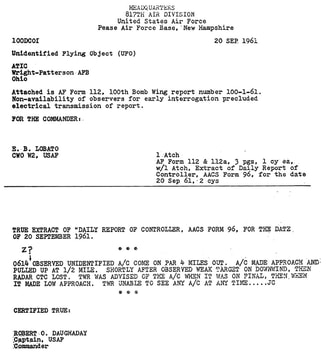 Radar report at 2:14 AM from Pease AFB. (Note: 0614 UTC(Z) = 0214 EDT)
Radar report at 2:14 AM from Pease AFB. (Note: 0614 UTC(Z) = 0214 EDT)
The incident ended up in Project Blue Book, which lists radar confirmed targets that night at two Air Force facilities in the area: 5:22PM at North Concord (VT), and 2:14AM on the night at Pease (NH).
Project Blue Book concluded the following with regard to the first radar target (7 hours before the UFO sighting): "Relative low speed and high altitude coupled with erratic course including weather balloon."
The second radar target (report at right), if it was a flying saucer full of eager-for-squash-prep-ideas aliens, supposedly happened after the Hills' abduction (since, during the abduction, the flying saucer full of dentistry-challenged aliens remained on the ground). As you'll see from the Hills' drive, where I've accounted for their stated speed and all the stops, it's impossible to reconcile Fuller's and Marden's time stamps with the physical constraints of the space-time continuum so it's not possible to slot in this radar report to see where it occurred during their adventure.
A 1976 report by NICAP investigator John Paul Oswald explains this radar sighting was of an (unidentified) aircraft approaching the Pease Air Force Base runway in a normal landing pattern, 80 miles away from the Hills' sighting. The MUFON UFO Journal in October 1979, reproduced on NICAP's website, admitted there is no evidence that the Hill case was tracked on radar.
More significantly, we have a flying saucer cavorting around the night skies for more than two hours (while the Hills drove from Mt Prospect to the close encounter one mile south of the Indian Head Resort) as well as additional flying time as it approached and left planet Earth, yet none of this was picked up on radar in the area.
Project Blue Book concluded the following with regard to the first radar target (7 hours before the UFO sighting): "Relative low speed and high altitude coupled with erratic course including weather balloon."
The second radar target (report at right), if it was a flying saucer full of eager-for-squash-prep-ideas aliens, supposedly happened after the Hills' abduction (since, during the abduction, the flying saucer full of dentistry-challenged aliens remained on the ground). As you'll see from the Hills' drive, where I've accounted for their stated speed and all the stops, it's impossible to reconcile Fuller's and Marden's time stamps with the physical constraints of the space-time continuum so it's not possible to slot in this radar report to see where it occurred during their adventure.
A 1976 report by NICAP investigator John Paul Oswald explains this radar sighting was of an (unidentified) aircraft approaching the Pease Air Force Base runway in a normal landing pattern, 80 miles away from the Hills' sighting. The MUFON UFO Journal in October 1979, reproduced on NICAP's website, admitted there is no evidence that the Hill case was tracked on radar.
More significantly, we have a flying saucer cavorting around the night skies for more than two hours (while the Hills drove from Mt Prospect to the close encounter one mile south of the Indian Head Resort) as well as additional flying time as it approached and left planet Earth, yet none of this was picked up on radar in the area.
Set the controls for the heart of the sun: Betty's star map
(Thanks to work by Robert Sheaffer, Marjorie Fish, Carl Sagan, Steven Soter, Charles Atterberg, Brett Holman, Armagh Observatory and Planetarium & others.)
The alien "leader" gives Betty Hill a quick peek at a rollaway star map, chides her for not understanding it, and refuses to explain it. Betty saw large and small dots representing stars, and "not straight" but "curved" lines representing trade routes and expeditions. It's not clear why a star map would have curved lines except as some indication of dimension on a 2D surface. Since the map is 2D, it makes sense Betty would describe it this way.
Under posthypnotic suggestion in 1964, Betty draws the star map with 26 stars and lines of different thicknesses.
Betty gets excited about a 1965 New York Times article reporting on a possible ET signal CTA-102 originating in the Pegasus constellation. She thinks it's a match for her star map and copies across the names. Fuller even includes it in The Interrupted Journey. (The signal turns out to be a humdrum quasar.)
The alien "leader" gives Betty Hill a quick peek at a rollaway star map, chides her for not understanding it, and refuses to explain it. Betty saw large and small dots representing stars, and "not straight" but "curved" lines representing trade routes and expeditions. It's not clear why a star map would have curved lines except as some indication of dimension on a 2D surface. Since the map is 2D, it makes sense Betty would describe it this way.
Under posthypnotic suggestion in 1964, Betty draws the star map with 26 stars and lines of different thicknesses.
Betty gets excited about a 1965 New York Times article reporting on a possible ET signal CTA-102 originating in the Pegasus constellation. She thinks it's a match for her star map and copies across the names. Fuller even includes it in The Interrupted Journey. (The signal turns out to be a humdrum quasar.)
In 1966, Marjorie Fish (elementary school teacher and MENSA member) becomes interested in deciphering Betty's star map. She plans to model the dots in 3D space and match them to real stars, thus uncovering the aliens’ homeworld.
The problem is that Betty's map is 2D. It was a rollaway affair, remember? 1950s technology. Odd. Anyway, Fish writes to Betty to resolve the problem:
The problem is that Betty's map is 2D. It was a rollaway affair, remember? 1950s technology. Odd. Anyway, Fish writes to Betty to resolve the problem:
Thanks to Fish's suggestion that the map must've been 3D, suddenly Betty recalls that the map she saw was 3D. Problem solved. Betty explains she drew the closer stars bigger, and Fish makes the logical assumption that one of the two huge stars is probably the aliens' homeworld. She also assumes our sun is on the map somewhere, since the aliens were, at the time, on a denture-finding expedition to Earth.
For six years Fish pores over star catalogs, especially each new edition of the Gliese Catalogue of Nearby Stars. She finds 1000 stars within 53 light years of our sun and eliminates those that probably don’t have habitable planets (because they are binary stars, variable stars, dwarf stars, etc.). This leaves her with just 46 stars.
This woman is dedicated: she hangs colored beads all over her ceiling with fishing wire at a scale of one quarter-inch per light-year. She examines the model from every angle looking for the dots to line up with Betty's sketch.
For six years Fish pores over star catalogs, especially each new edition of the Gliese Catalogue of Nearby Stars. She finds 1000 stars within 53 light years of our sun and eliminates those that probably don’t have habitable planets (because they are binary stars, variable stars, dwarf stars, etc.). This leaves her with just 46 stars.
This woman is dedicated: she hangs colored beads all over her ceiling with fishing wire at a scale of one quarter-inch per light-year. She examines the model from every angle looking for the dots to line up with Betty's sketch.
In 1969 she matches most of the stars, with the focal stars being Zeta Reticuli - a binary system visible from the southern hemisphere of Earth.
In 1972, with the latest edition of Gliese, she has a eureka moment. She's found all 12 stars that have trade/expedition routes including our sun, along with a triangle of three stars on the left that Betty had initially said were, along with the others, random. One of these is Gliese 86.1, which was unknown in 1964.
So, now we know: the aliens come from Zeta Reticuli!
(Astronomers say Zeta Reticuli has no indication of planets, by the way.)
In 1972, with the latest edition of Gliese, she has a eureka moment. She's found all 12 stars that have trade/expedition routes including our sun, along with a triangle of three stars on the left that Betty had initially said were, along with the others, random. One of these is Gliese 86.1, which was unknown in 1964.
So, now we know: the aliens come from Zeta Reticuli!
(Astronomers say Zeta Reticuli has no indication of planets, by the way.)
In 1974 Fish announces her findings at a UFO symposium. This gives actual astronomers the chance to take a closer look at her data.
And the whole thing quickly falls apart.
This doesn't deter true believers like Betty Hill or Stanton Friedman. Friedman encourages the editor of the fledgling Astronomy Magazine to write about the Hills’ aliens from Zeta Reticuli. This draws some rediculi and destroys the editor’s reputation somewhat.
The magazine opens up discussion on the star map for a year, publishing the views of both advocates and "debunkers" such as Carl Sagan and Steven Soter who suggest that any random assortment of dots is going to line up with something if you look for long enough. They replot the stars with a computer to get a more accurate chart of Fish's stars. Without the lines leading you to see a pattern, these stars no longer look anything like Betty's dots.
And the whole thing quickly falls apart.
This doesn't deter true believers like Betty Hill or Stanton Friedman. Friedman encourages the editor of the fledgling Astronomy Magazine to write about the Hills’ aliens from Zeta Reticuli. This draws some rediculi and destroys the editor’s reputation somewhat.
The magazine opens up discussion on the star map for a year, publishing the views of both advocates and "debunkers" such as Carl Sagan and Steven Soter who suggest that any random assortment of dots is going to line up with something if you look for long enough. They replot the stars with a computer to get a more accurate chart of Fish's stars. Without the lines leading you to see a pattern, these stars no longer look anything like Betty's dots.
There are plenty more problems with Fish's solution, and these issues have only magnified over the decades as we get more accurate information about these stars. For example:
Using Fish's criteria for which stars to include and exclude, the latest data we have would eliminate all but 9 of her matches.
But what bugs me most about Betty's star map is the weird way she drew the two biggest stars that came to be labeled Zeta 1 & 2 Reticuli. These stars are only about 0.06 light-years apart. On the scale Betty (and presumably the aliens) used, they should be almost on top of each other. Instead they are widely spaced. Fish fudged this by moving them closer in her diagram (for no reason), but still not close enough.
And why did Betty draw curved horizontal lines across those two big stars? Nobody draws stars like that. She's made them look like solid spheres.
As for those multiple heavy lines between Zeta 1 & 2, what's that all about? This is supposedly a "trade route" but looks more like a superhighway of interstellar shipping lanes.
It also looks kinda like this:
- Four stars that Fish deemed suitable for life turned out to be variable or close binaries, and should've been excluded using her own criteria (54 and 107 Piscium, Gliese 67, Tau 1 Eridani).
- Epsilon Eridani, which Fish excluded as a binary, is not a binary star and should've been included.
- Fish named a 16th star (Zeta Tucanae) and concludes it's not on Betty's map because it's obscured by Zeta Reticuli. Assuming the alien's map was 3D, Betty - who viewed it from 3 feet away - only had to move her head slightly to see this star. Apparently she was frozen with awe.
- Additionally, parallax observations made by the Hipparcos satellite in the early 90s have given us more accurate distances to these stars that don't match Fish's data from much earlier catalogs.
Using Fish's criteria for which stars to include and exclude, the latest data we have would eliminate all but 9 of her matches.
But what bugs me most about Betty's star map is the weird way she drew the two biggest stars that came to be labeled Zeta 1 & 2 Reticuli. These stars are only about 0.06 light-years apart. On the scale Betty (and presumably the aliens) used, they should be almost on top of each other. Instead they are widely spaced. Fish fudged this by moving them closer in her diagram (for no reason), but still not close enough.
And why did Betty draw curved horizontal lines across those two big stars? Nobody draws stars like that. She's made them look like solid spheres.
As for those multiple heavy lines between Zeta 1 & 2, what's that all about? This is supposedly a "trade route" but looks more like a superhighway of interstellar shipping lanes.
It also looks kinda like this:
Remember, Betty didn't have the benefit of futuristic sci-fi references for what a "star map" would look like. She'd never seen Hubble telescope pictures or browsed the internet. Her experience was limited to text books and museums and the night sky. Her hypnotist told her to draw a star map, and it seems she included the projector.
> Go to Hills main page, in which you can start all over again.
(c) Charlie Wiser 2021

